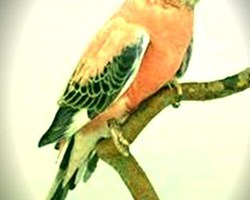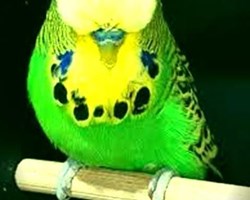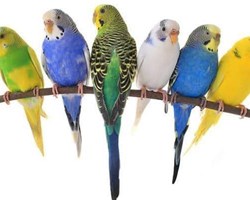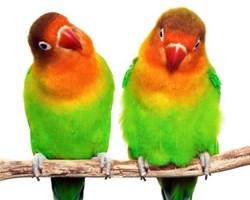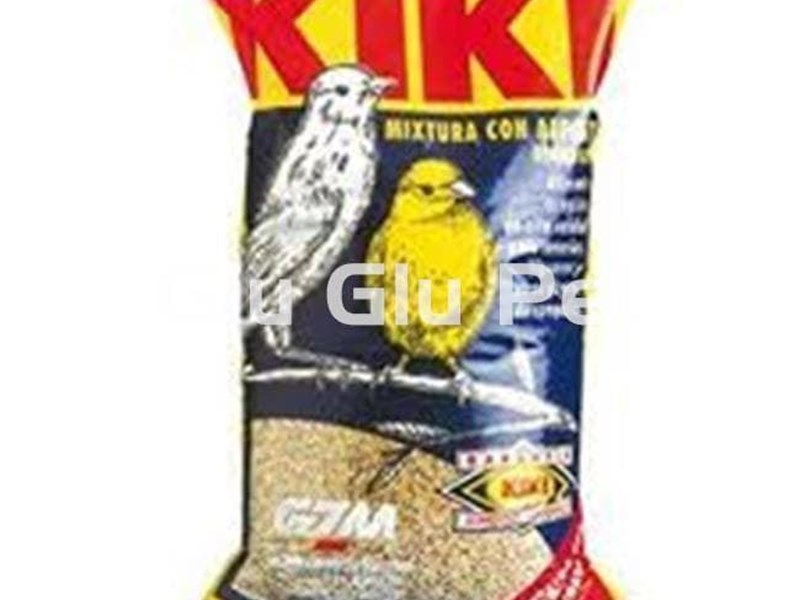
THE DIET:
WATER:
As in all living organisms, water is an essential element for birds; Under no circumstances should they remain without water for more than two hours.
It has been shown that a canary dies if it is without water for two days.
It seems that passerines are able to use the water obtained from seeds and leaves more effectively, and therefore can remain without a supply of this element for longer; if you don't want to have trouble, it is preferable not to put this ability to the test.
More than half, by weight, of a bird's body is water; adult individuals have less water need than young people.
Water can be considered the essential vehicle for food in the digestive system.
It is also used to moisten the seeds in the crop and facilitate enzymatic digestion.
An important part of the blood is water (plasma and serum), as well as the lymph.
Water regulates body temperature.
JP Holsheimer states the following: "Birds lack sweat glands, and this differentiates them from Mammals. They release excess body heat through the lungs and air sacs. Excess heat is expelled through the lungs by breathing forced (which may indicate lack of oxygen). Birds lift and move their feathers to get rid of the heat deposited in the plumage, coming from the air sacs and the skin". " Practically all types of food contain water. Water is also produced, along with carbon dioxide, when the body generates heat through the internal combustion of protein elements, fats and carbohydrates. The animal is in conditions of take advantage of part of the water contained in the food, but simultaneously needs other water supplies that must be obtained through drinking. The higher the percentage of water in a food, the lower its nutritional value" (Holsheimer JP 1980, p. 55 ).
These data clearly show that birds must have access to abundant water throughout the year, even during the cold season.
Never give them hot water, as there is a risk that the animal will use it for bathing, with which the feathers, including those of the wing, could freeze and deteriorate quickly.
To prevent the water from freezing in winter, it is advisable to add three tablespoons of glucose to half a liter of water (vitamin-enriched glucose is sold at Glu Glu Pet); glucose not only prevents the water from freezing, but at the same time is an optimal restorative for birds.
You can also buy drinkers equipped with a thermostat and a built-in heating element, which are especially useful in certain circumstances.
FEEDING:
The seed mixtures granivorous birds must have a rich variety.
These animals not only consume seeds but also feed on vegetables.
For all tropical and subtropical species, the different varieties of millet seeds are very important in the diet: La Plata, red millet and white millet, among others.
Granivores such as cardinals and parakeets prefer to feed on canary grass (Phalaris canariensis), in addition to millet.
Canaryseed is sometimes known by the name "canary seed", but a distinction must be made between this name and mixtures suitable for canaries, of which there are various brands and compositions.
At Glu Glu Pet we have these:
- ICA PARAKETS VIT PRO.
- KIKI mix of canaries 1kg.
- Shambi mixture parakeets 1Kg.
- Wild food Prestige VERSELE-LAGA.
The true canary seed, or canary seed, is made up of several seeds.
In general, birds prefer the so-called Moroccan canary seeds, which have a high nutritional value (14% protein, 5% fat, 50% carbohydrates and 2% minerals).
It must be borne in mind that this composition is not only used as food for canaries, as is clearly deduced from the fact that it is involved in all the mixtures that are mentioned, this food is really appreciated by many species of birds.
It is better to separate large-seeded millet from small-seeded millet in two automatic feeders.
The birds are also supplied with other types of food, but those mentioned are undoubtedly the main ones.
To keep animals totally healthy and active, a good diet is essential.
It is necessary to supply captive animals, along with the diet based on seeds, proteins and other components, such as white worms, ant pupae, meal moths, flies, spiders, beetles, aphids (they are easy to locate in rosebushes and ivy). residues, dry bread dipped in milk, and cuttlefish bones.
It will be necessary to complete this diet with vegetables, fruit, berries and small stones and sand.
An interesting observation: seeds that are usually found in meadows can also be administered.
Wild thistle seeds (which cardinals and many species of tropical songbirds like very much), and especially seeds of caryophyllaceae.
Everywhere it is possible to collect abundantly excellent and very nutritious seeds that grow in the fields.
It is advisable to buy the seeds from a trusted seller, so that these seeds are of the highest quality, since if the seeds have been in storage for a long time they lose part of their nutritional value.
A ration of seed mixture for canaries can have the following composition:
- Canary seed (or canary seeds) 60 g
- Broken oat grains 45 g 50% starch.
- Different types of millet 45 g
- Rapeseed and turnip seeds 60 g
- Niger 30g
- sesame 15g
- Flax seeds 15 g 50% oil content.
- Plantain seeds 7.5 g
- Hemp seeds 7.5g
Treats for canaries:
- 5% blue poppy seeds 20% niger.
- 5% Meadow Seed 10% White Lettuce Seed.
- 5% hemp seeds 20% black lettuce seeds.
- 5% white poppy seeds 20% sesame seeds (Sesamum indicum).
- 10% wild thistle seeds.
Seed mix for indigenous European birds and suitable also for a mixed group of granivores in aviary:
- Canary seed 150 g
- Millet (La Plata, red or white) 30 g 75% starch.
- Broken oat grains 45 g
- Rapeseed 15g
- Turnip seeds 15 g
- Niger 25g
- Sesame seeds 9 g 25% oil content.
- Flax seeds 9g
- Hemp seeds 3g
Seed mixture for small finches:
- 55% panizo from Senegal 0.5% sesame seeds.
- 15% panizo 0.5% poppy seeds.
- 15% millet (White Pearl) 0.5% plantain seeds.
- 10% canary seed 0.5% niger.
- 3% husked oats.
Seed mix for larger tropical birds:
- 40% canary seed.
- 30% millet (White Pearl).
- 15% Japanese millet.
- 10% panizo
- 5% husked oats.
Mix of seeds for parakeets, lovebirds and parrots:
- 60-70% Japanese millet. La Plata millet, red millet and white millet.
- 20-25% canary seed (canary seeds).
- 10-15% whole oats and hulled oats.
Seed mixture for large parakeets and parrots:
- 23-35% canary seed.
- 10-15% whole and hulled oats.
- 10-20% millet, White Pearl. japanese millet etc.
- 30-40% sunflower seeds.
The composition of a seed: In addition to water, the elements that intervene in its composition are: fats, carbohydrates, proteins and minerals.
Fats are especially important during the winter months as they help keep animals warm.
They are also useful in the other months of the year, since they provide energy for flight, locomotion and other activities.
This applies to much of carbohydrates as well: they provide energy after digestion, in a sense they "burn" inside the body.
Proteins are essential for growth, for tissue formation and for preventing cell degeneration.
Minerals are especially necessary for young individuals, as they help build a strong skeleton and provide the blood, glands, and intestines with materials that will help them function.
The seeds that have a more adequate proportion of these elements are: seeds for canaries (canary seed), large and small grain millet, sunflower seeds (especially for large parrots and parakeets), hemp seeds, flax seeds, barley and wheat (preferably broken).
It is advisable to always have an abundant quantity of seeds and other foods at home.
You must have an emergency reserve for unforeseen cases.
However, it is necessary to avoid keeping the seeds for a long time, since they must be fresh, it is necessary to renew the reserve.
Why should a variety of seeds be used?
Birds need a wide variety of food to develop and keep their bodies healthy.
Food should be rich in protein, fat and carbohydrates, in addition to minerals, which are very important.
Calcium, potassium, sodium, magnesium, phosphorus, sulfur, iron, fluorine and chlorine are among the essential elements for the formation and maintenance of all animal organisms.
Potassium, sodium, calcium and iron, among others, serve as prevention against certain parasites.
Sodium favors the release of carbon dioxide produced by the combustion of food, together with chlorine it forms sodium chloride, which is present in circulating fluids (blood and lymph).
Calcium and magnesium are essential for the formation of bones and certain tissues, in addition, without calcium, healthy blood cannot be formed.
The iron and magnesium present in the blood help fix oxygen from the air in the lungs, creating the right conditions for good circulation.
Sulfur promotes good feather growth, while chlorine (present in sodium chloride or common kitchen salt) favors the construction of tissues.
The most important seeds to achieve a balanced diet are, among others, turnip seeds, canary seed, hemp seeds, broken oat grains, millet, lettuce seeds, flax seeds, poppy seeds and niger.
It is preferable to put turnip seeds in a separate feeder, so that the amount consumed by the birds can be controlled.
The remaining seeds can be mixed, as long as the proportions given in the previous table are taken into account.
If you want to get a basic seed mix that is suitable for any bird species, follow this recipe: six parts broken oats, two parts turnip seeds, one part millet seeds, one part niger and a part of hemp.
It is difficult to provide a fair proportion of flax seeds. These act practically as a good laxative in most species, but many of them do not like them and therefore putting them in the mix is a waste of time.
The same rule also applies to millet (White Pearl).
The canaries reject it, but the exotic species like it.
All the seeds that an animal eats are used by the various internal organs.
Each excess overloads the body and decreases its efficiency.
A series of fermentations take place in the intestines, especially in the presence of excess protein.
Among other possible problems by this route, some poisons can be produced that intoxicate the blood, with negative effects on the conditions of the organism and its functionality.
If the question is examined from the biological point of view, it is verified that proteins are transformed into sugars in the liver. This conversion produces at the same time urea, which is toxic, the urea is filtered and removed by the kidneys.
In case of overfeeding, the organs fail to perform their functions properly. This produces an excess of rejected and unabsorbed materials, which seek their way out through the blood.
The end result is intoxication. Fortunately, nature is wise, and animals follow the instructions of their instinct. They eat only what is necessary for their health and really select the foods that are necessary for them. The only function of the poultry farmer is that the amount of food is adequate.
It is important to have adequate knowledge of the use of the different seeds and the importance of a balanced diet,
To this end, the main seeds are discussed in more detail below:
Turnip seeds (Brassica rapa):
Turnip seeds are one of the most important that are part of the mixtures for canaries.
Its fat content keeps the animals fit and healthy.
This also applies to exotic species.
Turnip seeds also contribute to the beauty of the feathers and make the throat more elastic and soft.
It is practically impossible to keep a songbird, with a melodious song, without turnip seeds being present in its diet.
Feeding with turnip seeds presents some problems, since if they are not kept in a dry place they quickly deteriorate and their nutritional value is nullified.
Roughly, the composition of turnip seeds is as follows:
- 12% water.
- 3.7% protein.
- 80% fat and carbohydrates.
- and the rest of the minerals.
Turnip seeds, to be good, must taste like nuts; otherwise they should not be used.
Poultry farmers dedicated to the breeding of canaries often speak in summer of sweet turnip seeds, which can easily be confused with rapeseed.
Both seeds cannot be distinguished by color, as rapeseeds are normally rinsed and take on the same color as summer sweet turnip seeds.
A Dutch expert. A. Bartels has written: "When viewed under a microscope, turnip seeds have a different structure from rapeseed, but this difference is not noticeable to the naked eye.
The surest test for distinguishing turnip seeds is taste; they should have a slight nutty flavor without being bitter. Rapeseed, which is also slightly fattier, lacks this flavor."
Despite the fact that turnip seeds occupy the first places in importance in relation to the diet of songbirds, there is the strange circumstance that the animals consume them in less quantity than the other seeds; this is positive, since if the animals consumed these seeds in excess they would gain too much weight.
It is advisable to place the turnip seeds in a separate feeder, since in this way the animals can easily regulate their consumption.
This method also reduces waste, since if the turnip seeds are fed mixed with other seeds at this precise moment, the animals do not feel a particular desire to consume them, they will reject all the food.
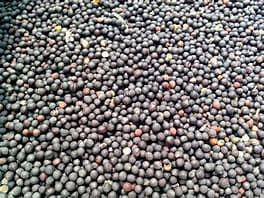
Canary seed or canary seeds (Phalaris canariensis):
The fundamental ingredient of a seed mixture is the canary seed, also known by the name of canary seed or by the common designation of bird food.
They are yellow, bright and pointed seeds.
The proportion in which these seeds must intervene in the mixture has already been commented on previously.
Canary seed contains a lot of starch, and experience shows that an excess of this component has a negative impact on the song of the birds.
Some poultry farmers give the greatest importance to this component, because they think that it is responsible for the beauty of color and shape of the animals, and therefore they provide it in abundance.
Birdseed contains approximately:
- 14% water.
- 3.5% minerals.
- 11% protein.
- 51% carbohydrates.
- 1% fat.
Canaryseed is commercially available in two main forms: Moroccan canaryseed, the large-grained variety, and Turkish, the small-grained variety.
These seeds come from an annual plant that blooms in the period between June and autumn.
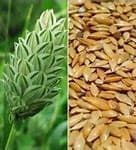
Hemp Seeds (Cannabis sativa):
When these seeds reach maturity they present white grains: if the grains are green it means that the seed is not ripe.
Hemp has a hard outer shell that can only be broken by adult animals.
Feeding these crushed seeds is preferable, but not entirely, as crushed seeds spoil quickly and are harmful to animals.
Hemp contains approximately:
- 12.5% water.
- 4.5% minerals.
- 12.2% protein.
- 16.6% carbohydrates.
- 30.2% fat.
These seeds are especially useful for overwintering females that live in cold environments, as they improve their resistance.
In these cases, quantities higher than usual can be supplied without causing damage.
The seeds are also used to help a weakened animal to recover its optimal condition.
Hemp seeds tend to cause an astringent effect, so it should be ensured that animals consume them at the same time as vegetables and greens.
These seeds come from an annual plant that flowers between July and August.
Currently, in many countries the cultivation of this plant is illegal, due to its connotations with drug use.
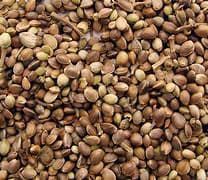
Broken oat seeds (Avena sativa):
Oat seeds are light yellow in color and are marketed as whole seeds or broken seeds.
They are easily digestible and stimulate the metabolism in a satisfactory way.
They are generally sold in broken form, but the author, Vriends Mathew M., recommends that in winter they be supplied whole to animals, since this forces them to break the caryopsis with their beak, which is an invigorating element for the organism.
Broken oat grains contain approximately:
- 14% water.
- 3.3% minerals.
- 8.9% protein.
- 4.5% carbohydrates.
- 3.2& of fats.
The plant blooms in July and August.
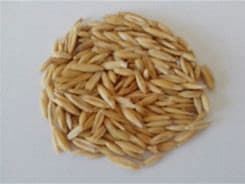
Lettuce seeds (Lactuca sp.):
These seeds are relatively expensive.
They have a slight laxative effect on the intestine and a favorable effect on the color of the plumage, which is why it becomes a top quality food.
Its composition is formed approximately:
- 93.3% water.
- 1% minerals.
- 1.4% protein.
- 2.2% carbohydrates.
- 0.3% fat.
Lettuce flowers between June and October.
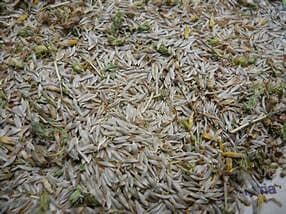
Flax seeds (Linum usitatissimum):
Flax seeds are easily recognized by their flat, dark grains.
Some authors maintain that they help moulting, especially in the case of canaries, but with a few exceptions these seeds are not consumed by birds.
They contain:
- 12.3% water.
- 3.4% minerals.
- 17.2% protein.
- 18.9% carbohydrates.
- 35.2% fat.
These seeds come from an annual plant, flax, which flowers between June and October.
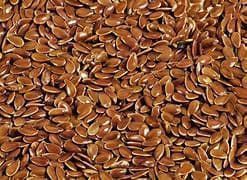
Poppy seeds (Papaver somniferum):
There are two different varieties of opium poppy: the blue (which is preferred by birds) and the white.
Its seeds favor water retention, so they are useful when it is detected that animals eliminate excessively liquid excrements.
Some authors maintain that the proportion of poppy seeds in the mixture should not be high, and they usually follow the recommendation to use two parts of poppy instead of four.
The body temperature of birds is very high, around 41º C, due to their high metabolism.
The metabolism is slightly stimulated by the effect of these foods by increasing the proportion of poppy seeds. Many dieticians agree that this procedure improves the body's functions.
Poppy seeds contain:
- 14.7% water.
- 5.3% minerals.
- 14.7% protein.
- 15.3% carbohydrates.
- 39% fat.
The opium poppy flowers between June and August.
Its cultivation is prohibited in many countries.
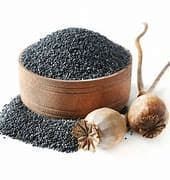
Niger seeds (Guizotia abyssinica):
These seeds look like shiny black rods.
Birds, especially canaries, consume them with pleasure.
Contains:
- 18% protein.
- 16% carbohydrates.
- 43% fat.
These seeds come from a plant of the genus Guizotia and are imported from East Africa.
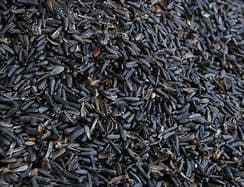
Sunflower seeds (Helianthus annuus):
These seeds are white with black stripes.
They contain:
- 15% albumin.
- Minerals.
- Vitamin E.
They are obtained from the sunflower plant, which blooms between July and October.
Together with millet, these are the most important seeds to form a good mix.
They contain all the basic elements to guarantee the birds proper development and maintenance.
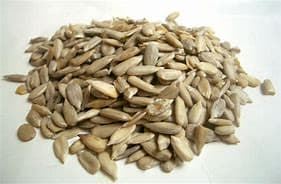
Insects as Food:
Numerous species of birds feed on insects, and these include "insectivores", so named to distinguish them from granivores.
Insectivores are known to regularly consume different types of indigestible materials, which they later regurgitate in the form of pellets.
This non-digestible material stimulates the production of gastric juices, but it is not used.
To stimulate the formation of regurgitation, small shredded feathers should be fed to the birds, preferably twice a week.
If animals are observed to regurgitate, there is no need to worry, as it is a completely natural phenomenon.
For the feeding of insectivores, Glu Glu Pet sells good products, suitable for all insectivorous birds, including spectacled birds, the Japanese sparrow, different species of cardinals, Shama's blackbird, etc.
The great advantage of these foods is that they contain a mixture of various species of dried insects.
You can also find in Glu Glu Pet food suitable for animals with small beaks and food for animals with large beaks, such as minnows, thrushes and the like.
Along with such meals, animals must necessarily be supplied with live food.
The variety in feeding is an important aspect to take into account for the health of the birds.
You can also try the supply of ox heart, which must be macerated, and served cooked or raw, although in small quantities, mixed with pieces of biscuit or bran.
Lightly crushed worms, shrimp, beetles and caterpillars can also be added to the mix.
Each supply should be made in small amounts, and repeated twice a day.
Before serving, moisten the bites with carrot juice or grated apple, or with water (although it is preferable to use carrot juice).
Keep in mind that the mixture should never be soaked excessively, but only moistened.
This also applies to the products sold in Glu Glu Pet,: in case of soaking, it must be superficial.
During the summer it is preferable to supply small amounts several times a day.
White Worms (Enchytraes):
Initial individuals can be obtained by searching under pieces of rotting wood or under leaf litter on the ground.
These are small, thin, white worms that are easy to grow.
For this, a box of about 35x35x25 cm is enough, which is filled with humus and decomposing leaves.
The material should not be compressed too much, but should be kept loose and slightly moist but never completely dry.
With the use of a small hoe, a hole is opened in the center, with a diameter of about 15 cm.
A bit of soaked white bread is placed at the bottom and the colony of worms is placed on top.
The box is then covered with a hermetically sealed glass, and then a newspaper is placed on top so that the breeding area is dark.
The soil must be checked regularly so that it does not dry out and check that the worms have enough food.
After a few weeks, worms can be collected at will; once washed in running water, they constitute one of the best delicacies that can be offered to cage and aviary birds.
It is very useful to have this type of material during the bird's breeding season, when they feed their young.
The optimum temperature for good worm breeding should be around 12º C.
Diptera larvae:
The culture of these larvae is very unattractive, and few poultry farmers are willing to do so.
But if you want to try, just have a place in the open air where you can leave a piece of meat.
The meat will attract flies, which will lay their eggs on it.
After a few days, remove the piece of meat and place it in a metal container with a cover that can be hermetically closed.
Days later a large number of larvae can be collected.
There is another method for obtaining this type of larvae, simpler and cleaner.
It is enough to fill a container with boiled potatoes and milk, and leave it in the open air without covering it; After a few days, the container is covered and a good number of larvae will be obtained.
These require some previous operations before supplying them to the birds.
They must be cleaned under a strong stream of running water for at least fifteen minutes, as this cleans the larvae of their stomach contents.
They take on a white color and only then are they ready to be fed to the birds.
Mealworms (For sale at Glu Glu Pet):
This material must be available throughout the year, especially at the beginning of the reproductive period.
They should not be supplied in excessive quantities, since otherwise the animals will gain weight, become more clumsy and even become incapacitated for incubation.
To obtain mealworms, you must use a 50x25x25 cm box, with three holes of about 3 cm in diameter on each side, placing a net that prevents any escape.
These holes must be made about 2 cm from the bottom of the drawer, which must be hermetically covered, in order to prevent leaks and bad odours.
You can also make some holes for ventilation in the cover (which can exceed 3 cm in diameter) and place a net inside, as in the case of the side holes.
When the container is available, a layer of shredded straw about 5 mm thick is placed on the floor, covering it with an old cloth and placing successive layers until it reaches a height of about 3 cm from the edge of the box.
Finally, everything is covered with a piece of cloth and a sheet of thick cardboard.
Food is placed on top of the layers, for example moistened white bread, pieces of fruit and vegetables, etc. Once everything is completely filled, you have to make sure that the closure is well fixed.
Several adult worms (which can be purchased from Glu Glu Pet) are required to start the reproduction process.
The collection of the new worms must be done once a week, and they are located on the cardboard or the rags.
Before feeding birds with these worms, it is necessary to wash them under running water.
If large and small birds are available, it is advisable to cut off the heads of the worms, otherwise it may happen that a live worm travels through the crop of the feeding animal, which can be harmful.
Many species of insectivorous birds either shred the worms before eating them, or else quickly swallow them.
The outer part of the worms, the cuticle, is rejected.
Ant pupae:
No conscientious poultry farmer will deprive his animals of "ant eggs," as ant pupae are often mistakenly called.
They can be found in anthills and also under stones, under the bark of trees (on the side exposed to the sun), in the ground, and in many other places.
The species of common ant that lives in the meadows (Tetramonium caespitum) keeps its larval reserve very close to the surface, so that the pupae can be easily discovered; only the amount needed to feed a small number of birds and for a single supply should be collected.
If a larger quantity is required, the pupae of the red forest ant (Formica rufa) anthills, or of other species of the same size, which produce larger pupae and also in greater quantity, should be taken.
If worked properly, a single anthill will be enough to supply all the necessary larvae for several years.
The structure of the anthill must be studied in order to discover the position of the stores, and with great care the twigs, pine needles and other materials must be removed until reaching the chamber in which the pupae are found (gloves must be used and protect sleeve openings, plus appropriate footwear).
A piece of cloth should be unfolded next to the nest, and fold the four corners inwards until there is adequate space in which to place the pupae.
Keep in mind that the pupae die quickly if they are exposed to the sun.
The ants notice this, and if they see that the larvae remain in the center of the fabric exposed to the sun, they will try to move them to a nearby shaded spot, which will be the folds of the collector's clothing.
The ants themselves will be in charge of separating the pupae from the detritus and placing them in the folds of the prepared cloth.
Folding the fabric may also pick up some ants, but don't worry.
When you get home, just open the lid of the pupae container and place it in the aviary.
The ants will try to run away and will be quickly captured by the birds.
A stock of pupae can also be kept in the refrigerator, after the birds have been treated to a bowl of ant eggs.
Keep in mind that the trick to separate the ants from the larvae depends on the sun, so the collection must necessarily be done on sunny days.
It is not recommended to completely deplete an anthill.
If the nest is too destroyed or the population too low, the reserve may be lost.
If the pupae are stored, they lose all their nutritional value.
You can contribute to repairing the damage by restoring all the nest material to the site, and doing it in an orderly manner, placing it on the edge of the open hole.
After three or four days the ants will have repaired the hole, and things will return to order inside the nest, there will be no trace of the raid.
In any case, it is advisable to produce the least possible disturbances to the anthill.
Any poultry farmer, as a lover of nature, will try to damage it as little as possible.
In this way, the ant colony can be maintained over time and become a good food supply for the birds for many years.
worms:
Earthworms only dig up those soils in which chemical fertilizers and similar substances have been added, since they keep a certain amount of soil in the body.
The bird that eats a worm can be poisoned by its soil content.
This can be fatal and at least create some problems, for example the appearance of a certain fragility in the eggs or the existence of a very hard membrane in the egg, two factors that necessarily limit reproductive success.
When digging the ground for worms, just stick the hoe into the ground and the worms will quickly come out; you just have to pick them up.
The author is not very supportive of the use of worms, since they can act as an intermediate host (carrier) of tracheal worms.
Other poultry farmers have had good results using earthworms; its possible use is the decision of the caregiver.
Crustaceans:
There are quite a few species of birds that like to consume crustaceans, and with some practice it is possible to discover which inhabitants of the aviary are favorable to this food.
The problem is that pollution makes it increasingly difficult to obtain clean water.
There are still ponds, streams, swamps and lakes in which water fleas (Daphnia) and other small species of crustaceans abound.
These animals are an excellent food for many species of birds, especially those that have red colors in their plumage, for which their consumption is essential.
The positive effect of the consumption of crustaceans for the maintenance of the red color of the plumage was demonstrated some years ago, when a group of ibises only developed this color in the plumage when they were placed in a pond with an abundant population of water fleas.
Ivy and rose aphids (among others) also produce the same effect, and it is advisable to provide our birds with a twig full of aphids from time to time. The birds will appreciate it.
To capture small crustaceans, a small strainer with a very fine nylon mesh can be used and passed repeatedly over the surface of the water.
Mason to the egg or breeding food:
Expert poultry farmers know that not all brands of mason or egg noodles are equal when it comes to quality.
It often takes some time to find the type that meets the needs and health of our animals.
Sometimes the birds are not well until they find the right food, and even then the breeder is not entirely sure that he has found the best food.
Many fans are unaware of the composition of the masons, since almost ninety percent of it does not appear on the packaging.
With experience, it will be possible to know quickly if the nutritional value of the different ingredients is adequate and if their composition has a favorable influence on the health of the animals.
Beginners sometimes acquire a large quantity of an unknown prepared food.
After a few months their animals begin to lose heart and get fat, they remain sleepy, and in a short time they are unable to incubate, sing, fly well or even walk.
The reason must be found in the fact that the food consumed contains too many vitamins or too many minerals, and that in any case does not respond to a balanced diet.
It is also true that there are prepared meals of excellent quality, and that they can be used without problem in animal feed.
These producers have a long experience that guarantees with absolute safety the preparation of a meal of the highest quality.
Expert poultry farmers usually prepare the egg mason themselves: if this operation is carried out properly, there will be no problem.
When the nutritional value reaches too high values, the birds are supplied with an excess of vitamins, carbohydrates, fats and minerals.
It is easier for individuals, young or old, to die from the consumption of too concentrated food than from exposure to cold.
We must insist on this point: you should not be in a hurry to prepare the food for your animals yourself and you should never do it before knowing its exact composition: when you buy it at Glu Glu Pet, you should always choose a brand known that can offer guarantees in this regard.
Another danger of home-prepared meals is that they spoil quickly, especially in summer, when this type of food is most necessary.
Every year numerous birds die from intestinal disorders caused by a storage error, by eating spoiled food full of harmful bacteria.
In general, homemade egg mason is usually more expensive than products in Glu Glu Pet, which at the same time offer greater safety during a longer period of conservation.
Preparing meals at home is labor intensive and requires space in the refrigerator to prevent spoilage quickly.
A recipe for egg mason:
For all those hobbyists who want to brave the above difficulties, a recipe is included that for Vriends, Mathew M. has proven to be satisfactory after several years of use.
Take an egg, beat it and make an omelette with the minimum amount of butter or oil. Then take four slices of sponge cake and crumble them.
Then cut the tortilla into very small pieces and mix it with the pieces of cake.
Finally, add finely grated carrots and apples to the mixture (if necessary, a pear can be used, but apples are better).
Make sure that everything is well mixed, preferably using an electric mixer.
Then add the juice of half an orange and 25-30 g of finely crushed hemp seeds (using a rolling pin) and some lettuce and poppy seeds.
It should be remembered that this mixture does not resist heat and that it must be kept inside the refrigerator.
Each time a small amount must be supplied, and the part that the birds do not consume before going to sleep must be removed.
Sand or pebbles:
Finely crushed shell-based litter is found in Glu Glu Pet; There are also different brands, but it is preferable to choose a well-known one.
It must be supplied daily to the animals, since it performs an important function in the digestion of the seeds.
Birds kept in cages can be supplied with sand from shells and river sand; aquarium sand, washed, is well suited for this use.
Vriends, Mathew M. prefers oyster shell-based litter, which is sold in metal boxes or plastic bags.
If the animals are installed in an aviary where they can peck the grains of soil from the ground, once removed, they will have at their disposal what is necessary for the digestion of the seeds in the stomach.
It is not advisable to supply beach or dune sand, as it has an excessive salt content and causes the birds to drink continuously, which in turn can cause disorders and other inconveniences.
Limestone:
Birds must take daily a certain amount of limestone.
They also require a daily ration of cuttlefish bone (the inner shell), which is readily available.
Both in the event that the bone is found on a beach or comes from its purchase in Glu Glu Pet, it should be washed for several days in clean water, changing it two or three times a day, it must be avoided that the bone is not too salty .
Another suitable source of limestone is the use of crumb calcium phosphate.
Lime must be supplied primarily during the incubation and moulting period.
In the so-called "juvenile moults" (in the case of canaries), limestone is a basic element.
By "juvenile moult" is meant the time in which the young specimens lose their plumage although they retain their wing and tail feathers.
In most cases, if the food and environment are suitable, this type of moult does not pose any particular problem.
Minerals:
The development of an adequate metabolism requires the supply of inorganic materials in the form of minerals.
These are necessary for the normal development of the skeleton, for the replacement and growth of tissues, for the regulation of blood osmotic pressure and for the pH balance of circulating fluids, for the transport of oxygen, for the production of red blood cells and for other bodily functions.
The lack of minerals is therefore very dangerous, since it can cause all kinds of deficiency diseases.
Calcium:
Among other functions, calcium is necessary for the development and maintenance of bones (skeleton), for blood coagulation, and for proper heart and nerve function; It also serves for the formation of the egg shell.
Calcium (Ca), along with other sources, is found in cuttlefish bones, calcium phosphate, and gypsum.
Bibliography:
- Vriends Mathew M. (1988). Cage Bird Guide. Grijalbo Editions, Barcelona.
- Holsheimer JP (1980). Voeding van Vogels, Thieme, Zutphen, The Netherlands.

